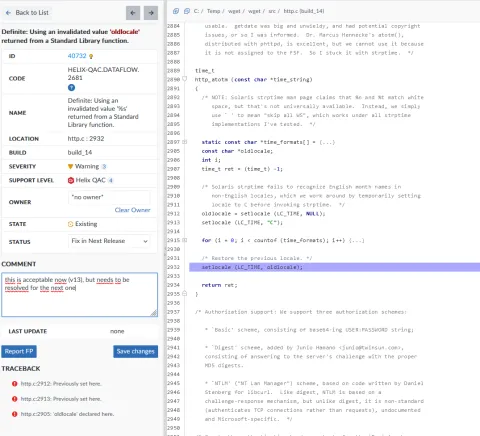Blog
July 5, 2023
What Are ADAS? Advanced Driver Assistance Systems Overview
Security & Compliance,
Software Quality
What are ADAS? Advanced driver assistance systems (ADAS) help improve the safety of everyone in the car to help them arrive safely at their destination. These technological features are essential as the majority of serious car accidents are due to human error.
Here we discuss what are advanced driver assistance systems (ADAS), provide examples of advanced driver assistance systems, and what coding standards are essential to the development of advanced driver assistance systems.
Read along or jump ahead to the section about advanced driver assistance systems that interests you the most:
Table of Contents
➡️ Free 7-Day Static Analysis Trial
Back to topWhat Are ADAS? Advanced Driver Assistance Systems
Advanced driver assistance systems are technological features that enhance safety systems that prevent car accidents and help drivers operate a vehicle safely.
Advanced driver assistance systems are use a human-machine interface to improve the safety and reaction times of the driver through early warning and automated systems.
Examples of Advanced Driver Assistance Systems (ADAS)
SAE International, formerly named the Society of Automotive Engineers (SAE), has defined SAE J3016, a standard which categorizes ADAS into different levels based on the level of automation provided.
Some advanced driver assistance systems features have become standard components of automotive software, including automatic braking systems (ABS) and adaptive cruise control (ACC). While others are available as add-ons, like automatic parking, blind-spot monitors, and collision avoidance monitors.
In addition, there are some features that are exclusive to fully autonomous cars.
📕 Related Resource: Learn more about autonomous cars and the six different autonomy levels.
Back to top
Why Are Advanced Driver Assistance Systems Important for ADAS Autonomous Driving?
Advanced driver assistance systems are important because according to the National Highway Traffic Safety Administration, an estimated 94% of serious car accidents are due to human error. Fortunately, even the most basic advanced driver assistance systems — like ABS — can help improve the safety of everyone in the car.
High Expectations for Advanced Driver Assistance Systems Need Tough Requirements
Where well-established assistance systems such as ABS, ESP, or cruise control are considered a given, the increasingly complex nature of cars make it necessary that each component is held to the highest standard of safety.
Modern vehicles not only need to manage the drivetrain but also infotainment, network and connectivity in addition to all safety measures. Unfortunately, despite some items being very isolated from one another, features cannot just be added one on top of another.
Lane-keeping assist doesn't just detect when your car starts to drift; it alerts the driver and tries to keep the car in its lane. This involves external sensors as well as the infotainment system for sound and visual warning, plus power steering to turn the wheel.
Adaptive cruise control also involves sensors and has a direct influence on the drivetrain.
Automatic Emergency Braking (AEB) also takes sensor information to then control the drivetrain.
And these are just examples using level 1 automations, where parameters are mostly known and controlled. The more complex the feature, the higher its complexity — and it becomes exponentially more difficult to guarantee its safety, following tougher and tougher requirements.
Back to topWhich Standards are Important for Advanced Driver Assistance Systems (ADAS)?
In order for advanced driver assistance systems to operate safely and reliably, they need to be developed following the right functional safety and security standards. These, in turn, require safe and secure coding standards to be enforced.
ISO 26262 for Advanced Driver Assistance Systems (ADAS)
A risk-based functional safety standard, ISO 26262 applies to the electric and electronic systems in vehicles including advanced driver assistance systems (ADAS) components. The standard outlines specific steps for each phase of the automotive equipment and systems lifecycle to ensure safety from the earliest concept.
Automotive Safety Integrity Levels (ASILs) are a key component of ISO 26262, as they measure the level of risk for automotive equipment and system components. The more complex the piece of equipment or system is, the greater the risk that there’ll be a systemic or hardware failure.
📕 Related Resource: Learn more about ISO 26262 and ASIL.
SOTIF (ISO 21448) for Advanced Driver Assistance Systems
SOTIF (ISO 21448) is a functional safety standard that provides guidance on design, verification, and validation measures to achieve safety of the intended functionality (SOTIF). It considers situations that cause safety hazards that do not result from system failures.
It applies to systems where the proper situational awareness is critical to safety especially emergency intervention systems (e.g. emergency braking systems) and Advanced Driver Assistance Systems (ADAS) with levels 1 and 2.
Only faults not already covered by other standards are considered and is not intended for existing functions like dynamic stability control (DSC) systems or airbags.)
ISO 21448 complements ISO 26262, as it covers malfunctions not resulting from system failure and those from technical shortcomings caused by the original design. Some of the measures apply to innovative updates of previous functionality.
Both of these standards place requirements on software, which can be best enforced by learning more about ISO 21448 and ISO 26262.
ISO 21434
Released in , ISO 21434 is an automotive standard that focuses on cybersecurity risks in the electronic systems of road vehicles. The standard ensures that cybersecurity considerations are incorporated into every part of the software development of automotive devices and products.
📕 Related Resource: Learn more about ISO 21434 and how to prepare for it.
CERT C
CERT is a secure coding standard that supports C, C++, and Java — all of which are used in the development of automotive software. The standard helps to identify and eliminate software security vulnerabilities as the code is being written.
📕 Related Resource: Learn more about CERT C and secure coding standards.
MISRA
MISRA provides coding guidelines for developing safety-critical systems, including automotive software in C and C++. Compliance with the standards is strongly recommended as it helps to ensure that automobiles are safe and reliable.
📕 Related Resource: Learn more about how to improve embedded coding with MISRA.
AUTOSAR
AUTOSAR has developed a coding standard for C++14, for the Autosar Adaptive Platform for connected and autonomous vehicles. This helps to ensure that automotive software is safe, secure, and reliable.
📕 Related Resource: Learn more about AUTOSAR coding guidelines.
Back to top
How Static Analysis Helps Ensure Safe, Reliable Advanced Driver Assistance Systems (ADAS)
The most efficient and effective way to ensure that software in advanced driver assistance systems are safe, secure, and reliable is to use a static analyzer — like Helix QAC.
A static analyzer helps enforce automotive coding guidelines — such as MISRA and AUTOSAR — and is certified for use with functional safety standards — such as ISO 26262.
By using Helix QAC, you are to apply coding guidelines to verify that your software meets the necessary requirements. In addition, Helix QAC can also improve the quality of your software by:
- Enforcing coding standards and detecting rule violations.
- Detecting compliance issues earlier in development.
- Accelerating code reviews and manual testing efforts.
- Reporting on compliance over time and across product versions.
While Helix QAC is mostly used directly by software developers for immediate feedback on their code quality and compliance (in the Helix QAC GUI or directly in Eclipse, VSCode or Visual Studio with official plugins), Helix QAC can also integrate within an established continuous integration or continuous deployment (CI/CD) environment.
Analysis can be configured and run through scripts for easy deployment, and results are then visible in the Validate platform for review and report generation. Validate also comes with its own API to make interfacing with other tools as convenient as possible.
Here is an example, below, from the local Helix QAC GUI, where a project analyzed for MISRA C:2012 allows you to quickly identify and filter issues that can be deemed most critical (in this case, a MISRA mandatory rule).

Find another example below of how an issue is reported in the Validate platform. The issue is interactive and can, for example, be assigned to someone, have its status changed, or have a comment added (useful in the case of deviations, for example).

With the size of projects increasing to the point they're almost impossible to humanly manage, it's essential to have tools that work together to give the most pertinent information as quickly as possible, so you can confirm that your project is compliant to the requirements set.
See how Helix QAC can help you produce safe, secure, and reliable automotive embedded software.

